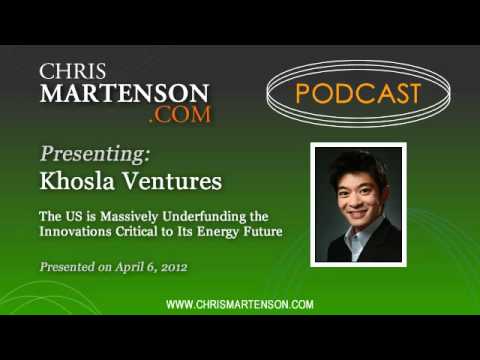While perhaps more optimistic than Chris on the odds that the world can transition off fossil energy sources without experiencing some duration of lower overall energy output, Andrew is clear to point out that large and near-term capital investments are essential for such a smooth transition.
The size and scale of the investments necessary to evolve and replace our existing (and increasingly outdated) power infrastructure are enormous, and too big for private companies alone to address the issue on an acceptable timeline.
And as of now, the U.S. is decidedly NOT treating the matter with the urgency it deserves. Of the total U.S. budget, the Department of Energy receives only 8%; and only 0.1% of the total budget is directed to the alternative technologies we hope will one day replace our fossil-based sources. By contrast, China alone is dedicating $800 billion over the next ten years to help support the development and commercialization of alternative technologies and cleantech.
In the coming decades, the efficient and effective use of energy is going to be a real determinant between winners and loser across the global landscape. Affordable, sustainable energy will increasingly determine the prosperity of world powers -- and America is at a growing relative disadvantage until it starts talking honestly with itself about the un-sustainability of its current energy policies and prioritizing its resources (both monetary and human) accordingly.
Despite these concerns, Andrew and Khosla have a lot of optimism for the impact new technological innovations will have in addressing the energy challenge -- a number of which are discussed in this interview. And they encourage companies, capital and workers to enter the sector, as demand for expertise and solutions will be high for a very long time. And the future price of NOT investing ourselves wholeheartedly at this time is unacceptably dear.
On the End of the Age of "Cheap Oil"
I think that the scarcity of oil -- hitting Peak Oil -- and the increasing cost of being able to extract and discover new oil deposits is making it more and more costly. And importantly, the demand for energy and oil is going up dramatically with a lot of the emerging countries like China and India just exploding in demand as the countries develop into more urban economies.
If you look at the demand for electricity and energy in China, that has gone up tenfold over a period of about 15-20 years. India has gone up about fivefold, whereas the U.S. has only doubled in that period of time. So you can see that with these emerging economies being very aggressive in their domestic growth, the demand for oil and the demand for electricity is just going to go up dramatically and that is going to make the cost of oil at a minimum, stable, if not going up over time.
On the Obsolescence of the U.S. Energy Grid
We are looking at an energy infrastructure that is 40-50 years old. If you have ever been to an actual power plant or looked at the inside of a transformer substation, it is a spaghetti of wires that was designed in an era where we don’t have the computing capability and the circuitry and so forth that we have today.
So a lot of the initiatives right now are really around making the software on the backside much more up to date. The sensing capability, like the smart grid and smart meters that you would have at your home, and then adding additional infrastructure like storage capability that did not exist in a cost-effective form 10 or 15 years ago -- or even, frankly, two years ago. So, there is a lot of opportunity over time to upgrade that infrastructure in a massive way to make more efficient use of the energy generation that we have right now.
On the New Energy Arms Race
It is going to be difficult for the market to solve the problem alone without government intervention and capital dollars, just because of the massive scale of the problem. If you look at manufacturing, whether it is solar panels, or producing biofuel, manufacturing LEDs -- these are all large manufacturing businesses that if you want to even scratch the surface on the amount of energy that we need, fuel that we need, it requires substantial, substantial investments.
When you are talking about the scales that you need to reach in order to make a real difference, again sources of capital can really help here I think the government needs to really help support and foster these types of technologies so that promising entrepreneurs and promising startups don’t get lost in a private capital-unfriendly environment today. China, as you mentioned, is really trying to lead the way here, in a very aggressive way.They already are number one today in terms of the amount of capital that they are committing to alternative energy sources, electricity production, and fuels production. In their most recent announcement on their next five-year plan, they are essentially pledging $80 billion every year for the next ten years to help support the development and commercialization of alternative technologies and cleantech. That is a massive number: $800 billion that is being committed over a period of a decade to do this.
If you look back at what we were doing in Washington just several years ago with the stimulus package, there was a lot of excitement and strain and stress about putting several tens of $billions into the stimulus package for various types of renewable energy, energy infrastructure improvement. Today, some of that money has gone out, some of it may not get fully deployed. Then, with a lot of negativity in the press today, a lot of the folks in Washington are actually pulling back a bit in terms of their support of the clean technology ecosystem. So, if you think about us putting the brakes on a relatively modest level of investment in clean technology and you compare that to what China is doing and other countries are doing (there are a number of countries in Europe, for example, that are investing a significant amount per capita in clean technology), it just puts us at a disadvantage relative to the long-term viability of scaling up alternative technologies in the U.S.
Click the play button below to listen to Chris' interview with Andrew Chung of Khosla Ventures (runtime 44m:45s).
iTunes: Play/Download/Subscribe to the Podcast
Download/Play the Podcast
Report a Problem Playing the Podcast
Or click here to read the full transcript.
Andrew, a Partner at Khosla Ventures, is interested in developing leading companies in cleantech, Internet, mobility, education, and genomics and also leads the firm’s China activities. He is one of six Partners at Khosla and is a director on the boards of Lanzatech (biofuel), LS9 (biofuel), EcoMotors (transportation), Pellion (storage), Biodiscovery (agriculture), and a stealth company (mobile).
Prior to Khosla, Andrew spent five years at Lightspeed Venture Partners and helped to build the firm's cleantech practice. He helped drive and manage Lightspeed's investments in Solazyme (NASDAQ: SZYM, biofuel), Stion (solar), LS9 (biofuel), Coaltek (clean coal), Leyden Energy (energy storage), Orbis Education (nursing), and Personalis (genome interpretation).
In addition to assisting portfolio companies, Andrew was Founding Chair of the Cleantech Board for The Indus Entrepreneurs Group (TiE) and is a long-time advisor to the Cleantech Open (CTO). Andrew delivered the keynote address at the CTO’s 2011 National Finals Gala and will be the opening keynote speaker at Cleantech Investment World Asia 2012, the largest conference of its kind in Asia. Andrew has also advised a number of government officials on cleantech-related policy issues.
Our series of podcast interviews with notable minds includes:
- Charles Biderman
- Gretchen Morgenson
- Chris Martenson (answers your questions - part 2)
- Marc Faber
- Robert Mish
- Erik Townsend
- Ben Davies
- Jim Rickards
- Chris Martenson (answers your questions)
- Charles Eisenstein
- James Dines
- John Mauldin
- Jack Keller
- Rick Rule
- Robert Rapier
- Gordon Chang
- Turd Ferguson
- Eric Janszen
- Paul Brodsky
- Carolyn Baker
- David Stockman
- Rob Hopkins
- Joel Salatin
- Charles Hugh Smith
- Frank Barbera
- Nate Hagens
- David Morgan
- James Turk
- Eric Sprott
- John Rubino
- Addison Wiggin
- Simon Black
- Axel Merk
- Paul Tustain
- Francis Koster
- Dogs_In_A_Pile
- Bud Conrad
- John Williams
- Robert McFarlane
- David Collum
- Joe Saluzzi
- Jim Rogers
- Bill Fleckenstein
- Marc Faber
- Willet Kempton
- Dan Ariely
- Ted Butler
This is a companion discussion topic for the original entry at https://peakprosperity.com/khosla-ventures-the-us-is-massively-underfunding-the-innovations-critical-to-its-energy-future-3/

